What’s Up For April 2016?
What’s Up for April 2016?
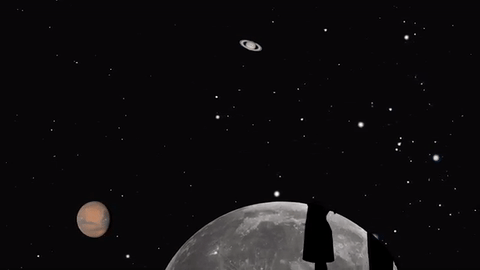
Jupiter, Mars, the Lyrid meteor shower and 2016’s best views of Mercury are all visible in the sky this month.
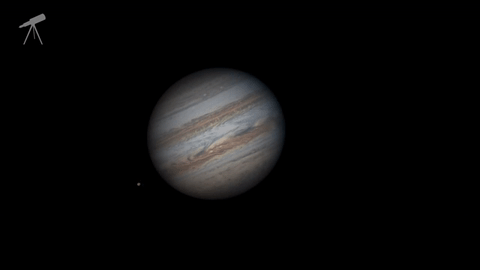
Jupiter, where our Juno mission will begin orbiting on July 4, continues to shine almost as brightly this month as last. And eagle-eyed telescope viewers will see a transit, a shadow transit, an occultation and an eclipse of Jupiter’s moons- all in one night: April 6-7.
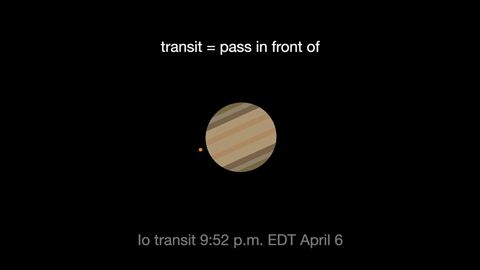
Io transits first, crossing the planet beginning at 9:52 p.m. EDT. It’s shadow can be seen less than an hour later.
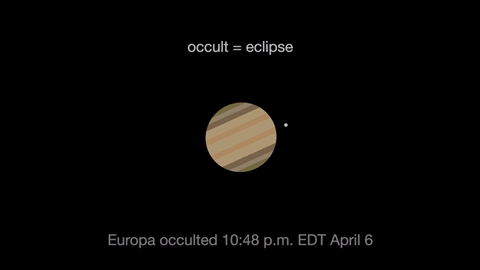
Next Jupiter occults, or eclipses, Europa as Europa slips behind the giant planet at 10:48 p.m. EDT. At 3 a.m. Europa reappears from its eclipse, dramatically leaving the shadow of Jupiter.
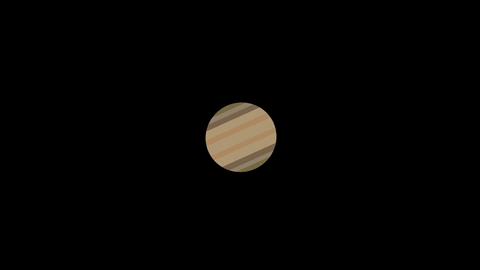
Ganymede transits the planet beginning at 1:01 EDT April 7.
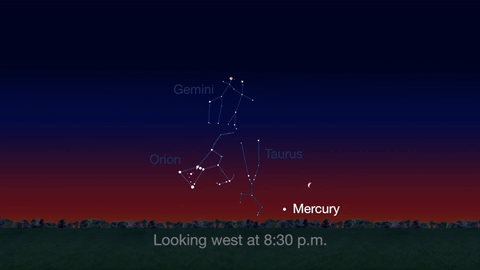
Check out the other planets in April, too! Mercury is always a challenging object to view, but this month you can spot it after sunset about 10 degrees above the horizon. Through a telescope you can see its phase. It will appear like a tiny crescent moon, with about 1/3 of its disk illuminated.
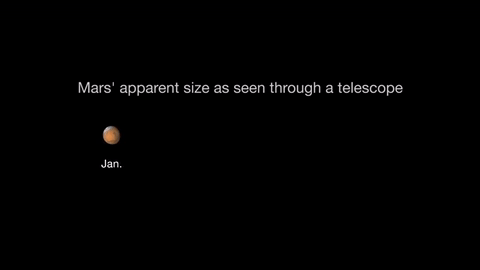
Mars is finally visible before midnight this month. It rises in the southeast at about 10 p.m. by the end of April. The best observing of Mars will be when it is highest in the sky. This means a few hours before dawn. Its brightness and apparent size increase dramatically this month. By month’s end, Mars appears nearly twice as bright as at the beginning of the month.
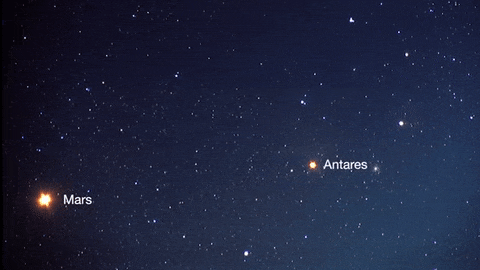
About mid-month you’ll see Mars near its rival in the sky: the similar-colored red supergiant star Antares. The name “Antares” means “equal to or rival of Mars”.
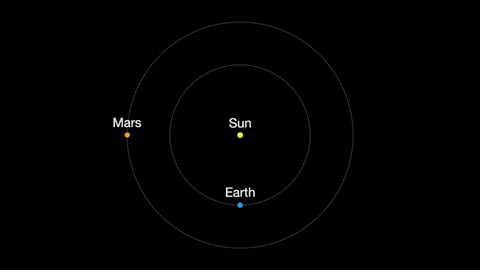
Earth moves almost twice as fast as Mars does, so it often passes Mars in their race around the sun. This causes “retrograde motion”: an illusion we see from our viewpoint on Earth.
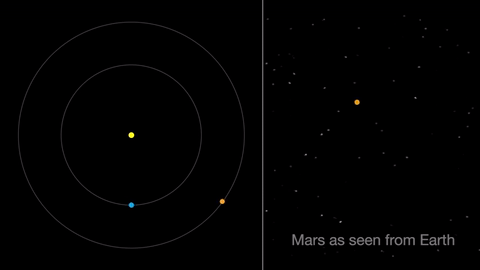
Retrograde motion happens as Earth catches up to Mars, causing Mars to appear slow to slow its eastward motion against the stars. After a few days, when Earth has overtaken Mars, the Red Planet seems to move westward. Eventually, Earth moves far enough around its orbit that Mars appears to be moving eastward again.
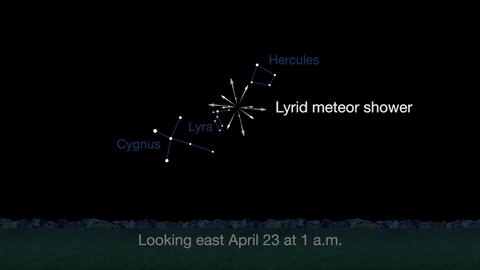
April features one meteor shower, the Lyrids. This year the Lyrids are marred by the full moon. The best time to view will be just before dawn on April 23, when the constellation Lyra is overhead and the moon will be near to setting.
With all of these great things to spot in the sky this month, be sure to get outside and look up!
Make sure to follow us on Tumblr for your regular dose of space: http://nasa.tumblr.com
More Posts from Bigbluenasa and Others

NASA Gemini Mission Spacewalk. Famous shot. Note the hand held maneuvering gun
Incoming! We’ve Got Science from Jupiter!
Our Juno spacecraft has just released some exciting new science from its first close flyby of Jupiter!

In case you don’t know, the Juno spacecraft entered orbit around the gas giant on July 4, 2016…about a year ago. Since then, it has been collecting data and images from this unique vantage point.

Juno is in a polar orbit around Jupiter, which means that the majority of each orbit is spent well away from the gas giant. But once every 53 days its trajectory approaches Jupiter from above its north pole, where it begins a close two-hour transit flying north to south with its eight science instruments collecting data and its JunoCam camera snapping pictures.

Space Fact: The download of six megabytes of data collected during the two-hour transit can take one-and-a-half days!

Juno and her cloud-piercing science instruments are helping us get a better understanding of the processes happening on Jupiter. These new results portray the planet as a complex, gigantic, turbulent world that we still need to study and unravel its mysteries.
So what did this first science flyby tell us? Let’s break it down…
1. Tumultuous Cyclones

Juno’s imager, JunoCam, has showed us that both of Jupiter’s poles are covered in tumultuous cyclones and anticyclone storms, densely clustered and rubbing together. Some of these storms as large as Earth!

These storms are still puzzling. We’re still not exactly sure how they formed or how they interact with each other. Future close flybys will help us better understand these mysterious cyclones.

Seen above, waves of clouds (at 37.8 degrees latitude) dominate this three-dimensional Jovian cloudscape. JunoCam obtained this enhanced-color picture on May 19, 2017, at 5:50 UTC from an altitude of 5,500 miles (8,900 kilometers). Details as small as 4 miles (6 kilometers) across can be identified in this image.

An even closer view of the same image shows small bright high clouds that are about 16 miles (25 kilometers) across and in some areas appear to form “squall lines” (a narrow band of high winds and storms associated with a cold front). On Jupiter, clouds this high are almost certainly comprised of water and/or ammonia ice.
2. Jupiter’s Atmosphere
Juno’s Microwave Radiometer is an instrument that samples the thermal microwave radiation from Jupiter’s atmosphere from the tops of the ammonia clouds to deep within its atmosphere.

Data from this instrument suggest that the ammonia is quite variable and continues to increase as far down as we can see with MWR, which is a few hundred kilometers. In the cut-out image below, orange signifies high ammonia abundance and blue signifies low ammonia abundance. Jupiter appears to have a band around its equator high in ammonia abundance, with a column shown in orange.

Why does this ammonia matter? Well, ammonia is a good tracer of other relatively rare gases and fluids in the atmosphere…like water. Understanding the relative abundances of these materials helps us have a better idea of how and when Jupiter formed in the early solar system.
This instrument has also given us more information about Jupiter’s iconic belts and zones. Data suggest that the belt near Jupiter’s equator penetrates all the way down, while the belts and zones at other latitudes seem to evolve to other structures.
3. Stronger-Than-Expected Magnetic Field

Prior to Juno, it was known that Jupiter had the most intense magnetic field in the solar system…but measurements from Juno’s magnetometer investigation (MAG) indicate that the gas giant’s magnetic field is even stronger than models expected, and more irregular in shape.

At 7.766 Gauss, it is about 10 times stronger than the strongest magnetic field found on Earth! What is Gauss? Magnetic field strengths are measured in units called Gauss or Teslas. A magnetic field with a strength of 10,000 Gauss also has a strength of 1 Tesla.

Juno is giving us a unique view of the magnetic field close to Jupiter that we’ve never had before. For example, data from the spacecraft (displayed in the graphic above) suggests that the planet’s magnetic field is “lumpy”, meaning its stronger in some places and weaker in others. This uneven distribution suggests that the field might be generated by dynamo action (where the motion of electrically conducting fluid creates a self-sustaining magnetic field) closer to the surface, above the layer of metallic hydrogen. Juno’s orbital track is illustrated with the black curve.
4. Sounds of Jupiter
Juno also observed plasma wave signals from Jupiter’s ionosphere. This movie shows results from Juno’s radio wave detector that were recorded while it passed close to Jupiter. Waves in the plasma (the charged gas) in the upper atmosphere of Jupiter have different frequencies that depend on the types of ions present, and their densities.
Mapping out these ions in the jovian system helps us understand how the upper atmosphere works including the aurora. Beyond the visual representation of the data, the data have been made into sounds where the frequencies and playback speed have been shifted to be audible to human ears.
5. Jovian “Southern Lights”

The complexity and richness of Jupiter’s “southern lights” (also known as auroras) are on display in this animation of false-color maps from our Juno spacecraft. Auroras result when energetic electrons from the magnetosphere crash into the molecular hydrogen in the Jovian upper atmosphere. The data for this animation were obtained by Juno’s Ultraviolet Spectrograph.

During Juno’s next flyby on July 11, the spacecraft will fly directly over one of the most iconic features in the entire solar system – one that every school kid knows – Jupiter’s Great Red Spot! If anybody is going to get to the bottom of what is going on below those mammoth swirling crimson cloud tops, it’s Juno.

Stay updated on all things Juno and Jupiter by following along on social media: Twitter | Facebook | YouTube | Tumblr
Learn more about the Juno spacecraft and its mission at Jupiter HERE.
(via https://www.youtube.com/watch?v=QMs7sWGm9q0)
Spacewalk Friday: Installing a New "Parking Spot" on Station
This Friday, Aug. 19, two U.S. astronauts will install a new gateway for American commercial crew spacecraft at the International Space Station.

Commercial crew flights from Florida’s Space Coast to the International Space Station will restore America’s human spaceflight launch capability and increase the time U.S. crews can dedicate to scientific research.

The adapter being installed (imaged below) was launched on a SpaceX Dragon cargo spacecraft and arrived on orbit July 20. NASA astronauts Jeff Williams and Kate Rubins will perform the spacewalk to install the equipment this Friday, Aug. 19. This will be the fourth spacewalk in Williams’ career and the first for Rubins.

Four previous spacewalks…like the one below…helped set the stage for installation of this docking adapter. During those previous spacewalks, other crew members laid hundreds of feet of power and data cables outside the space station.

On Wednesday, the robotics team using the Canadarm2 and its attached “Dextre” manipulator, will reach into the SpaceX Dragon trunk and pull out the docking adapter and position it for Friday’s spacewalk activities.

The morning of the spacewalk, while the astronauts are getting suited up, the robotic arm will position the docking adaptor near the port so that it will be ready for installation.

The two astronauts will venture outside the space station to install the first International Docking Adapter (IDA). This new adapter port will provide a parking space for U.S. Commercial Crew vehicles.
Watch LIVE!
Coverage of the spacewalk begins at 6:30 a.m. EDT on Friday, Aug. 19; with the spacewalk scheduled to begin at 8:05 a.m. EDT. Stream live online HERE.
Make sure to follow us on Tumblr for your regular dose of space: http://nasa.tumblr.com
The title says it all...MAKING Video Games...FOR NASA! :)
Elementary GLOBE is designed to introduce K-4 students to the study of Earth System Science. The complete instructional unit includes:
Science-based storybooks designed to introduce students to key concepts in water, soil, clouds, seasons, aerosols, and Earth system studies.
Classroom learning activities complementing the science content covered in each storybook that are designed to further engage students in GLOBE's 5 investigation areas.

Orion Nebula in Oxygen, Hydrogen, and Sulfur Image Credit Copyright: César Blanco González
The Orion Nebula is among the most intensely studied celestial features.The nebula has revealed much about the process of how stars and planetary systems are formed from collapsing clouds of gas and dust.
Astronomers have directly observed protoplanetary disks, brown dwarfs, intense and turbulent motions of the gas, and the photo-ionizing effects of massive nearby stars in the nebula.
2017 - Johnson Space Center Year in Review
(via https://www.youtube.com/watch?v=HU5kpIQ09Iw)

Not to spoil the movie, because it & the book are awesome. This is just something you can learn about Mars before or after you watch the movie, “The Martian.”
-
 carryonmycobaltangel liked this · 1 year ago
carryonmycobaltangel liked this · 1 year ago -
 pepperface97 reblogged this · 8 years ago
pepperface97 reblogged this · 8 years ago -
 pepperface97 liked this · 8 years ago
pepperface97 liked this · 8 years ago -
 onceagwen liked this · 9 years ago
onceagwen liked this · 9 years ago -
 fridaatzin95 liked this · 9 years ago
fridaatzin95 liked this · 9 years ago -
 jsclark1969-blog liked this · 9 years ago
jsclark1969-blog liked this · 9 years ago -
 addycted liked this · 9 years ago
addycted liked this · 9 years ago -
 safouane-reus liked this · 9 years ago
safouane-reus liked this · 9 years ago -
 doodlenova liked this · 9 years ago
doodlenova liked this · 9 years ago -
 bigbluenasa reblogged this · 9 years ago
bigbluenasa reblogged this · 9 years ago -
 santelmosundowner-blog reblogged this · 9 years ago
santelmosundowner-blog reblogged this · 9 years ago -
 spaceplasma liked this · 9 years ago
spaceplasma liked this · 9 years ago -
 halforcdad liked this · 9 years ago
halforcdad liked this · 9 years ago -
 satousei13 liked this · 9 years ago
satousei13 liked this · 9 years ago -
 samsgroves reblogged this · 9 years ago
samsgroves reblogged this · 9 years ago -
 iamdelph reblogged this · 9 years ago
iamdelph reblogged this · 9 years ago -
 durtschi liked this · 9 years ago
durtschi liked this · 9 years ago -
 smothernights liked this · 9 years ago
smothernights liked this · 9 years ago -
 scullywolf liked this · 9 years ago
scullywolf liked this · 9 years ago -
 dialmformara reblogged this · 9 years ago
dialmformara reblogged this · 9 years ago -
 allegoricalrose liked this · 9 years ago
allegoricalrose liked this · 9 years ago -
 pinchtheprincess liked this · 9 years ago
pinchtheprincess liked this · 9 years ago -
 tripwirealarm reblogged this · 9 years ago
tripwirealarm reblogged this · 9 years ago -
 onceuponaknittery liked this · 9 years ago
onceuponaknittery liked this · 9 years ago -
 mrwyx liked this · 9 years ago
mrwyx liked this · 9 years ago -
 pirateprincessyuki reblogged this · 9 years ago
pirateprincessyuki reblogged this · 9 years ago -
 ghoulish-activist-gay reblogged this · 9 years ago
ghoulish-activist-gay reblogged this · 9 years ago -
 ghoulish-activist-gay liked this · 9 years ago
ghoulish-activist-gay liked this · 9 years ago -
 evanthelynn reblogged this · 9 years ago
evanthelynn reblogged this · 9 years ago -
 pwdmt reblogged this · 9 years ago
pwdmt reblogged this · 9 years ago -
 pwdmt liked this · 9 years ago
pwdmt liked this · 9 years ago -
 prayingforpolya-blog liked this · 9 years ago
prayingforpolya-blog liked this · 9 years ago -
 kushiro-shiina-blog liked this · 9 years ago
kushiro-shiina-blog liked this · 9 years ago -
 sosayset reblogged this · 9 years ago
sosayset reblogged this · 9 years ago -
 fabio-tolio reblogged this · 9 years ago
fabio-tolio reblogged this · 9 years ago